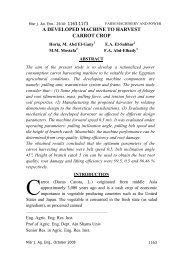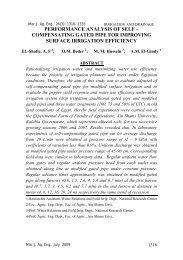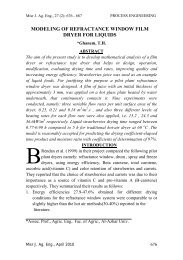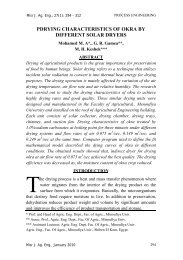Misr J. Ag. Eng., 26(3) - Misr Journal Of Agricultural Engineering ...
Misr J. Ag. Eng., 26(3) - Misr Journal Of Agricultural Engineering ...
Misr J. Ag. Eng., 26(3) - Misr Journal Of Agricultural Engineering ...
You also want an ePaper? Increase the reach of your titles
YUMPU automatically turns print PDFs into web optimized ePapers that Google loves.
4. Accumulation of salts in soil profile<br />
Figure (4) illustrates the variation of the average value of electrical<br />
conductivity (EC) in dS/m with soil depth for all the tested treatments. It<br />
showed that, applying treated sewage water produced higher values of EC<br />
in soil surface layers with all the used irrigation systems. In contrast, with<br />
Nile water, the accumulation of salts decreased with time where the<br />
average value of EC reached to its lowest value (0.85 ds/m) at a depth of<br />
10 cm of soil layer with all tested systems . Applying treated sewage<br />
water with sprinkler irrigation systems (rotary and spray heads)led to<br />
increasing the accumulation of salts with time. At the end of the growing<br />
season the salts accumulates sharply specially at the soil surface layers<br />
and it reaches 1.5 dS/m at a depth of 10 cm for the two sprinkler heads<br />
The least accumulation of salts at the end of the growing season was<br />
observed with Nile water under subsurface trickle with long path emitters<br />
and leaky pipes laterals. The value of EC reached to 1 dS/m with leaky<br />
pipes laterals and to 0.9 dS/m with long path emitters. With treated<br />
sewage water, the salts accumulate slightly from the beginning to the end<br />
of the growing season, where the value of EC reached to 1.3 dS/m with<br />
leaky pipes laterals while it remains constant at 1.2 dS/m for subsurface<br />
trickle with long path emitters. It also evident that, subsurface trickle<br />
irrigation system with long path emitters help in decreasing the<br />
accumulation of salts more than sprinkler systems. This may be due to the<br />
sufficient of water in soil profile that achieved with subsurface trickle<br />
irrigation system.<br />
5. Environmental impacts due to applying treated sewage water<br />
Reuse of the treated sewage water, as a new source of irrigation water<br />
will be accompanied with a number of environmental impacts on soil,<br />
plant and consequently on human body. Environmental impacts either in<br />
the cultivated soil or in the growing plant basically focused upon the<br />
change of the concentration of the existed heavy metals due to applying<br />
the treated sewage water.<br />
(a)Impacts on the cultivated soil<br />
Table (5) represents the average concentration of heavy metals in soil<br />
after applying treated sewage water and the standard concentration<br />
reported by World Health Organization WHO 1995 for each metal. It<br />
<strong>Misr</strong> J. <strong>Ag</strong>. <strong>Eng</strong>., July 2009 1236
















